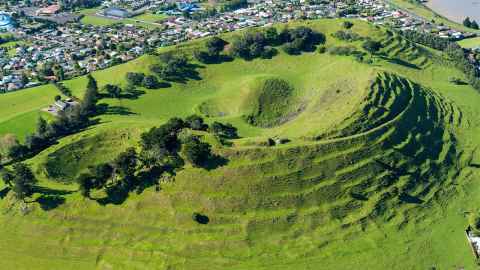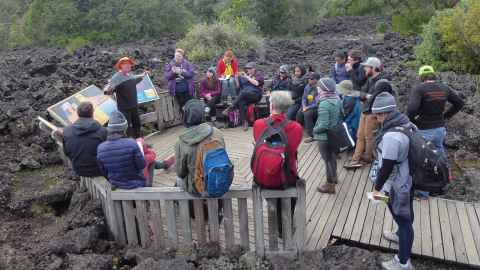Book: Volcanoes of Auckland, a Field Guide
25 November 2019
Bruce Hayward has written the perfect guide to take with you if you’re exploring Auckland’s volcanoes.

It’s been eight years since Bruce Hayward’s last handy field guide to Auckland’s volcanoes. Since then, science has made exploring volcanoes even more exciting. Bruce is an honorary research associate in the School of Environment, but is semi-retired.
His new book, Volcanoes of Auckland: A Field Guide, is a revamp of the earlier Essential Guide. About three quarters of the more than 400 photos, maps and diagrams are new. There’s a set of maps for each volcano, showing where all things of geological, historic, archaeological and recreational interest can be seen during a visit.
“It includes pages on the three additional volcanoes recognised by me since the last book was published – Boggust Crater, Cemetery Crater and Puhinui Craters,” says Bruce.
The area of greatest advance is new information on the ages of each volcano from studies by the Devora project. Devora stands for DEtermining VOlcanic Risk in Auckland and is a multi-agency, transdisciplinary collaborative research programme led by volcanologists at the University of Auckland and GNS Science.
Although Bruce is a geologist, marine ecologist and geoheritage conservationist rather than a volcanologist, he records his observations of the volcanoes of northern New Zealand in his own time and is a friend of Devora.
“Most advances in our understanding of how Auckland’s volcanoes erupt and their ages are derived from the Devora programme. There are now only about six volcanoes that haven’t been dated. All erupted between 190,000 years ago and 600 years ago. The three oldest are the explosion craters at Northcote-Takapuna Pupuke, Onepoto and Tank Farm/Tuff Crater.
“The youngest is Rangitoto, which erupted in two phases only a decade or two apart, 600 years ago. Suggestions Rangitoto may have erupted on and off for thousands of years are not supported by more recent Devora research.”

Bruce’s favourite Auckland volcano is Mangere Mountain.
“It is one of the best-preserved and has so many facets to look at and try to understand how the volcano was formed. It is the only one with an extruded lava plug that has been squeezed out of the vent by the last build-up of gas pressure beneath it – this forms the small hill in the middle of the crater.
“It’s also the best volcano for seeing volcanic bombs inside the crater. The bombs were globs of molten lava thrown out by the force of the gas that escaped from around the base of the plug as it was squeezed out of the volcano’s throat in the last phase of eruption.”
Bruce hopes his book will be very useful for teachers and schoolchildren.
“It will help them better understand how volcanoes were formed, how they’ve been modified and damaged, where they all are, what they look like now and what they can see if they go out to explore them.”
The book has aerial photos of each volcano or its site by nature photographer Alastair Jamieson – who has a Masters in Geography from Auckland. It also features old black and white photos and illustrations that show how the land around Auckland’s volcanoes has changed.
Volcanoes of Auckland: A Field Guide
Aerial photography by Alastair Jamieson
Bruce W Hayward, AUP, $49.99
ALUMNI GIVEAWAY: Win a copy of Volcanoes of Auckland: A Field Guide. Email your details to Ingenio@auckland.ac.nz by 27 January with Volcanoes in subject line. (Two copies to give away.)